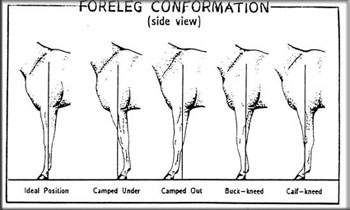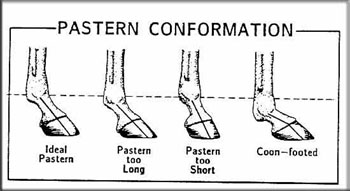
Many don't realize the importance in a horse's conformation. Not only for the horses performance, but also for their future soundness. So many times I have seen riders buy a horse because "he's so beautiful" or "he's so flashy" or they used logic similar to "well his sire did Grand Prix jumping so... So can he!"
Wrong.
I love my horse friends with all my heart and always wish to support their decisions, but it is so hard to stand back as they purchase a horse whom is clearly wrong for the discipline they want to do.
"Look at his long legs, he'll be able to jump the moon!" Maybe so, for a little while at least. But did you happen to see how ridiculously long his back is? Or how he is slightly over at the knee? For this particular example, both conformational faults could be detrimental to a horse in heavy jumping work.
For some, slight conformational flaws are completely fine for the type of leisure riding they want to do. For example, there are many horses that may not be suitable for jumping or reining, but would be perfectly suitable for light ranch work. There are also exceptions - racehorses born with poor leg conformation that have overcome the odds and won races or horses that have a crooked leg but perform well in dressage with the proper management.
I believe that horse people are generally good at heart, and genuinely never want to hurt their horses. However, I do believe that the majority of horse people are also uneducated when it comes down to what to look for when purchasing a horse.
There are some things about a horse we can change, and others we cannot. Some believe that with correctional shoeing, we can fix leg conformation. A little can be done with a horse is young, but by the time they are older not much can be done. We might be able to aide them slightly with correctional shoeing, but they will never really be "fixed".
I am not a veterinarian, nor do I claim to know everything about horses, but I wish to share some of my knowledge just so that people who are interested can have the information. I am sure there are more qualified blogs to be read, but I love to teach about what I love, so it's a fun way for me to do so.
Foreleg Conformation:
No legs, no horse. Foreleg conformation is especially important because horses bare the majority of their weight on them. When standing still, horses bare up to 65% of their weight on their forelegs, when jumping, they bare an immense amount of force on their forelimbs during their landing, and when galloping there is a moment during each stride where all of their weight is on their leading foreleg. When it comes down to it, no matter how beautiful or how well-pedigreed a horse is, if it doesn't have the proper leg conformation it may suffer from chronic lameness.
When looking at a horse from the front, we want to see straight legs. When looking at a horse from the side, we want to see proper angles. A horse with proper leg conformation with dissipate most of the concussion to the leg and hoof naturally as it moves.
When I say "straight legs", I mean that if you dropped what is called a "plumb line" down each leg from the point of the shoulder (Figure 1), the plumb line would run straight down the middle of the forearm, knee, cannon, fetlock, and hoof bisecting the leg. Typically when looking at the front of a horse, the side of the leg the plumb line falls closer to is the side of the horse's leg that will have lameness problems. If the horse is toed-in and the plumb line falls close to the outside of the legs, the horse is more likely to have lateral lameness. If the horse is toed-out and the plumb line falls closer to the inside of the legs, the horse is more likely to suffer from medial lameness. As you can see in the illustration below, all three of these horses are variants that have faults.
Figure 1
Figure 2
If you dropped a plumb line from the side, it should bisect the leg and then fall behind the heel. (Figure 2) Arguably the worst conformation fault is horse that is calf-kneed. Calf-kneed refers to a posterior deviation of the knee that will lead to a strain on the ligaments and fractures or chips of the carpel (knee) bones. A horse that is calf-kneed is almost guaranteed to be chronically lame when put in strenuous work.
There are many other deviants to figure 1, a common one being a toed-in horse, as mentioned earlier. A horse that is toed-in will move in a manner that is referred to as "winging out" or "paddling". A horse that is toed-out will move "winging in" which often times leads to interfering.
Figure 3
(A) is a horse with straight legs and proper conformation, (B) is a horse that is toed-out and will have legs that interfere when moving, and (C) is a horse that is toed-in and "paddling".
 When looking at the forearm and cannon, we want the length of the forearm to be longer than that of the cannon. The longer the forearm, the better, as it increases the area for muscle attachment. It also creates greater leverage, speed, and stride length. A short cannon is also an appealing attribute to a horses conformation, as it provides increased stability. Circumference-wise, if you measured around a horses cannon, an average measurement is 7-9 inches. Cannon bones smaller than this can lead to damaged bones, ligaments, and tendons if the horse is in heavy work.
When looking at the forearm and cannon, we want the length of the forearm to be longer than that of the cannon. The longer the forearm, the better, as it increases the area for muscle attachment. It also creates greater leverage, speed, and stride length. A short cannon is also an appealing attribute to a horses conformation, as it provides increased stability. Circumference-wise, if you measured around a horses cannon, an average measurement is 7-9 inches. Cannon bones smaller than this can lead to damaged bones, ligaments, and tendons if the horse is in heavy work.
Figure 4
Angles:
Two extremely important angles to look at are the angle of the shoulder and of the pastern.
The shoulder is an anti-concussive mechanism. The shoulder is ideally sloping and at an angle of 45-55 degrees. An ideal shoulder provides increased area of muscle attachment and will enhance extension and scope for jumping because the horse will be able to fold it's forelimbs tighter. A horse with a sloping shoulder will have a long stride which usually means less concussion, whereas a horse with an upright shoulder will have a shorter stride with more concussion - which also creates a choppy ride. In addition to an upright shoulder being less comfortable to ride, it is also one of the causes of navicular.
We want pastern angles to follow that of the shoulder and therefore to be at an angle between 45-55 degrees also. A horse with a long pastern is more likely to bow it's tendons, and a horse with a short/upright pastern moves with more concussion to the leg. A horse that is "coon-footed" has a pastern that will cause strain on the flexor tendons, sesamoid bones, and distal sesamoid ligaments.
Figure 5
With a brief introduction into conformation, there is so much more to know and so many lameness problems I haven't even mentioned. I am off to get ready for my day now so I have to do a "to be continued", but in the next post I will talk all about the hind limbs and the hoof.
Thanks for reading and I hope this was a helpful beginning!




No comments:
Post a Comment